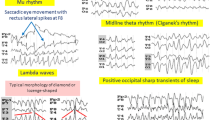Abstract
Neurobiological mechanisms determining a possibility of parsimonious descriptions of the continuous sleep process as a sequence of a few all-or-nothing variables called “sleep stages” remain unknown. We tested a suggestion that stage 1 sleep (“drowsy sleep”) corresponds to a rapid decay of a wake-promoting process and that the boundary with stages 2 separates this decay from a rapid buildup of a sleep-promoting process. The analyzed dataset included power spectra calculated from the electroencephalographic (EEG) records obtained during attempts of 15 adults to stay permanently awake for 43–61 h and during multiple napping attempts of nine sleep-deprived, nine sleep-restricted, and 11 sleep-unrestricted adults. The time courses of scores on the 1st and 2nd principal components of the EEG spectra reflected the suggested phase relationships between rapid changes in the sleep- and wake-promoting processes, respectively. The 1st principal component score was permanently attenuated during wakefulness and stage 1 sleep but started to build up on the boundary with stage 2. In contrast, the 2nd principal component score started to fall down near the wake-sleep boundary but remained unchanged across stage 2. We concluded that stage 1 sleep corresponds to the decay phase of the wake-promoting process that precedes the buildup phase of the sleep-promoting process during stage 2.
Similar content being viewed by others
References
Tanaka H, Hayashi M, Hori T. Statistical features of hypnagogic EEG measured by a new scoring system. Sleep 1996; 19: 731–8.
Ogilvie RD. The process of falling asleep. Sleep Med. 2001; 5: 247–70.
Rechtschaffen A, Kales A, eds. A Manual of Standardized Terminology, Techniques and Scoring System for Sleep Stages of Human Subjects. UCLA Brain Information Service/Brain Research Institute: Los Angeles, 1968.
Iber C, Ancoli-Israel S, Chesson AL, Quan SF. The AASM Manual for the Scoring of Sleep and Associated Events: Rules, Terminology and Technical Specifications. American Association of Sleep Medicine: Westchester, IL, 2007.
Silber MH, Ancoli-Israel S, Bonnet MH et al. The visual scoring of sleep in adults. J. Clin. Sleep Med. 2007; 3: 121–31.
Schulz H. Rethinking sleep analysis. J. Clin. Sleep Med. 2008; 4: 99–103.
De Gennaro L, Ferrara M, Bertini M. The boundary between wakefulness and sleep: quantitative electroencephalographic changes during the sleep onset period. Neuroscience 2001; 107: 1–11.
Wright KP, Jr, Badia P, Wauquier A. Topographical and temporal patterns of brain activity during the transition from wakefulness to sleep. Sleep 1995; 18: 880–9.
Dijk DJ, Brunner DP, Borbély AA. Time course of EEG power density during long sleep in humans. Am. J. Physiol. 1990; 258: R650–61.
Achermann P, Dijk DJ, Brunner DP, Borbély AA. A model of human sleep homeostasis based on EEG slowwave activity: quantitative comparison of data and simulations. Brain Res. Bull. 1993; 31: 97–113.
Borbély AA. A two process model of sleep regulation. Hum. Neurobiol. 1982; 1: 195–204.
Daan S, Beersma DGM, Borbély AA. Timing of human sleep: recovery process gated by a circadian pacemaker. Am. J. Physiol. 1984; 246: R161–78.
Donskaya OG, Verevkin EG, Putilov AA. The first and second principal components of the EEG spectrum as the indicators of sleepiness. Somnologie 2012; 16: 69–79.
Putilov AA. Principal component structure of wake-sleep transition: quantitative description in multiple sleep latency tests. Somnologie 2010; 14: 234–43.
Putilov AA. Prospects of using electroencephalographic signatures of the chronoregulatory processes for meaningful, parsimonious and quantitative description of the sleep-wake sub-states. Biol. Rhythm Res. 2011; 42: 181–207.
Putilov AA. Principal components of electroencephalographic spectrum as markers of opponent processes underlying ultradian sleep cycles. Chronobiol. Int. 2011; 28: 287–99.
Putilov AA, Donskaya OG, Verevkin EG. Quantification of sleepiness through principal component analysis of the EEG spectrum. Chronobiol. Int. 2012; 29: 509–22.
Putilov AA, Donskaya OG, Verevkin EG, Putilov DA. Associations of waking EEG structure with chronotype and trototype of 130 sleep deprived individuals. Biol. Rhythm Res. 2010; 41: 113–36.
Putilov AA, Donskaya OG, Verevkin EG, Shtark MB. Structuring the inter-individual variation in waking EEG can help to discriminate between the objective markers of sleep debt and sleep pressure. Somnologie 2009; 13: 72–88.
Åkerstedt T, Gillberg M. Subjective and objective sleepiness in the active individual. Int. J. Neurosci. 1990; 52: 29–37.
Henelius A, Korpela J, Huotilainen M. Individualising EEG frequency bands for sleep deprivation studies. Conf. Proc. IEEE Eng. Med. Biol. Soc. 2011; 2011: 6083–6.
Finelli L, Borbely AA, Achermann P. Functional topography of the human nonREM sleep electroencephalogram. Eur. J. Neurosci. 2001; 13: 2282–90.
Frigo M, Johnson SG. The design and implementation of FFTW3. Proc. IEEE 2005; 93: 216–31.
Merica H, Fortune RD. State transitions between wake and sleep, and within the ultradian cycle, with focus on the link to neuronal activity. Sleep Med. Rev. 2004; 8: 473–85.
Tanaka H, Hayashi M, Hori T. Topographical characteristics of slow wave activities during the transition from wakefulness to sleep. Clin. Neurophysiol. 2000; 111: 417–27.
Morikawa T, Hayashi M, Hori T. Spatio-temporal variations of alpha and sigma band EEG in waking sleeping transition period. Percept. Mot. Skills 2002; 95: 131–54.
Author information
Authors and Affiliations
Corresponding author
Rights and permissions
About this article
Cite this article
Putilov, A.A., Donskaya, O.G. Rapid changes in scores on the two largest principal components of the electroencephalographic spectrum demarcate the boundaries of drowsy sleep. Sleep Biol. Rhythms 11, 154–164 (2013). https://doi.org/10.1111/sbr.12017
Accepted:
Published:
Issue Date:
DOI: https://doi.org/10.1111/sbr.12017




